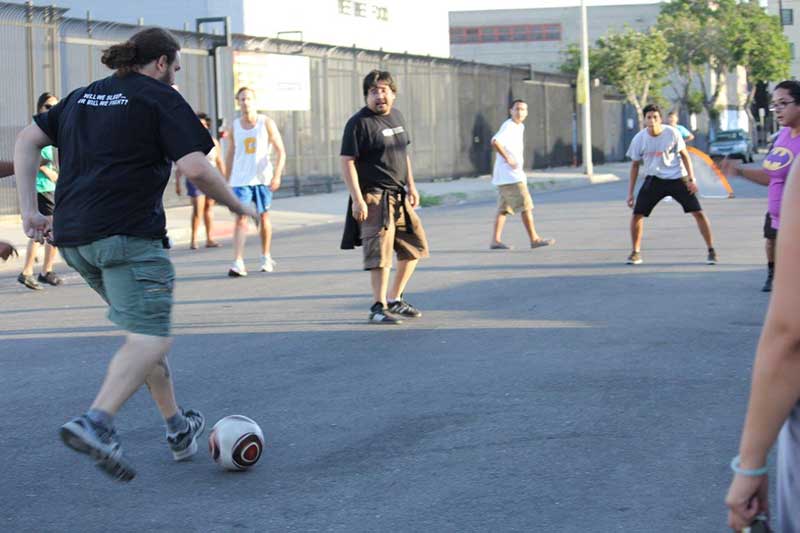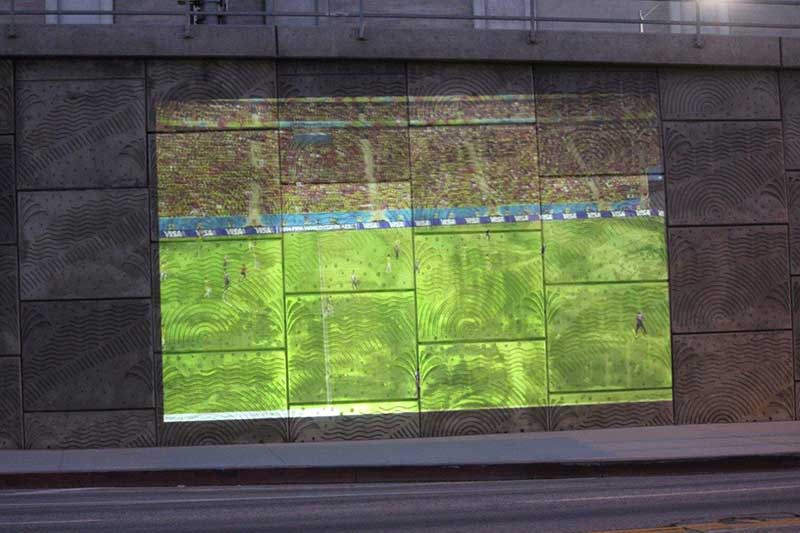
Art has long been a vehicle for protest, says Adam Vine ’01. By way of explanation, he cites the 13th-century legend of Lady Godiva. In riding naked on horseback through the streets of Coventry in demonstration against taxes imposed by her husband, the English noblewoman exemplified the idea of performance as protest.
Vine is a performance and video artist who, by incorporating elements of protest into his work, generates what he calls “creative collaborative action.” One example is People’s Cup L.A., an event Vine co-organized in 2014 to protest urban gentrification and the deportation of undocumented immigrants. It began with lunch and a soccer game in Los Angeles’ Skid Row. From there, demonstrators marched to the city’s Metropolitan Detention Center, where they projected a World Cup game on a wall, enabling detainees, undocumented and otherwise, to see the game from inside.
“The protest was organized in solidarity with people in Brazil who were displaced by the World Cup games, and who live in places like Skid Row, where people are in danger of displacement as Los Angeles continues to gentrify and expand,” Vine says. “It was also about increasing awareness and empathy for illegal immigrants, many of whom are held in prisons for no other reason, and calling attention to the pitfalls in our criminal justice system.

Vine’s interest in protest has Amherst roots that date before his own birth. His father, John M. Vine, graduated from Amherst in 1966, when some 20 seniors walked out of the Commencement ceremony as the College awarded an honorary degree to Secretary of Defense Robert McNamara. Though his father was not part of the walk-out, Vine grew up hearing about it and recently set out to learn more about it.
While visiting Amherst in May 2016 for his 15th reunion—also his father’s 50th—Vine went to Archives and Special Collections in Frost Library to research the history of demonstrations at Amherst. Sorting through old photographs and articles, Vine says, “it became clear to me that there’s been this kind of legacy of dissent at Amherst, mostly about racial issues, but also about politics and war.”
He returned to campus this fall to give a talk on “The Art of Protest: Politics, History, Ethics and Documentation,” in which he delved into the history of protest in general and at Amherst specifically, including the 2015 student protest in Frost Library.

He also talked about his own reasons for staging demonstrations. In addition to bringing awareness to social issues, Vine says his work aims to empower communities. “We’re dealing with some of the heaviest issues possible, and that can really grind you down if you work in these movements,” he told students in Keefe Campus Center. “The reason I inject art and creativity into protest is so that people leave with a smile.”
Vine has multiple projects now in the works. With Andrew Epstein ’02E, he founded Cage-Free Cannabis, a company that he says will sell environmentally conscious cannabis accessories and donate all profits to organizations that support people negatively affected by the war on drugs. He also plans to co-host a Passover seder on the U.S.–Mexico border, in order to “draw paralells between the seder story of liberation and the issue of immigration—and to envision a world without walls on our borders.”
Rachel Rogol covers the arts in the Amherst Office of Communications.